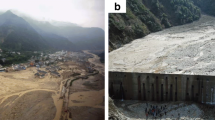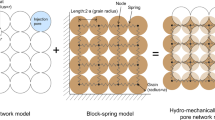Abstract
Here we investigate three long-standing principles of granular mechanics and avalanche science: dilatancy, effective stress and dispersive pressure. We first show how the three principles are mechanically interrelated: Shearing of a particle ensemble creates a mechanical energy flux associated with random particle movements (scattering). Because the particle scattering is inhibited at the basal boundary, there is a spontaneous rise in the center of mass of the particle ensemble (dilatancy). This rise is connected to a change in potential energy. When the center of mass rises, there is a corresponding reaction at the base of the flow that is coupled to the vertical acceleration of the ensemble. This inertial stress is the dispersive pressure. Dilatancy is therefore not well connected to effective-stress-type relations, rather the energy fluxes describing the configurational changes of the particle ensemble. The strict application of energy principles has far-reaching implications for the modeling of avalanches and debris flows and other dangerous geophysical hazards.






Similar content being viewed by others
References
Bagnold RA (1954) Experiments on a gravity-free dispersion of large solid spheres in a Newtonian fluid under shear. Proc R Soc Lond A 225(1160):49–63
Bartelt P, Buser O, Platzer K (2006) Fluctuation-dissipation relations for granular snow avalanches. J Glaciol 52(179):631–643
Bartelt P, Bühler O, Buser O, Christen M, Meier L (2012) Modeling mass-dependent flow regime transitions to predict the stopping and depositional behaviour of snow avalanches. J Geophys Res 117:F01015. doi:10.1029/2010JF001957
Bartelt P, Vera CV, Feistl T, Christen M, Bühler Y, Buser O (2015) Modelling cohesion in snow avalanche flow. J Glaciol 61(229):837–850. doi:10.3189/2015JoG14J126
Bartelt P, Buser O, Vera VC, Bühler Y (2016) Configurational energy and the formation of mixed flowing/powder snow and ice avalanches. Ann Glaciol. doi:10.3189/2016AoG71A464
Bouchut F, Fernandez-Nieto DE, Mangeney A, Narbona-Reina G (2015) A two-phase two-layer model for fluidized granular flows with dilatancy effects. https://hal-upec-upem.archives-ouvertes.fr/hal-01161930
Buser O, Bartelt P (2011) Dispersive pressure and density variations in snow avalanches. J Glaciol 57(205)
Buser O, Bartelt P (2015) An energy-based method to calculate streamwise density variations in snow avalanches. J Glaciol. doi:10.3189/2015JoG14J054
George D, Iverson RM (2014) A depth-averaged debris-flow model that includes the effects of evolving dilatancy II. Numerical predictions and experimental tests. Proc R Soc A 470:20130820. doi:10.1098/rspa.2013.0820
Goodman RE (1999) Karl Terzaaghi. ASCE press, Reston
Hunt ML, Zenit R, Campell CS, Brennen CE (2002) Revisiting the 1954 suspension experiments of RA Bagnold. J Fluid Mech 452:1–24
Issler D, Gauer P (2008) Exploring the significance of the fluidized flow regime for avalanche hazard mapping. Ann Glaciol 49:193–198
Iverson RM, Logan M, LaHusen RG, Berti M (2010) The perfect debris flow? Aggregated results from 28 large-scale experiments. J Geophys Res Earth Surf 115:F03005. doi:10.1029/2009JF001514
Iverson R, George D (2014) A depth-averaged debris-flow model that includes the effects of evolving dilatancy I. Physical basis. Proc R Soc A 470:20130819. doi:10.1098/rspa.2013.0819
Kaitna R, Dietrich WE, Hsu L (2014) Surface slopes, velocity profiles and fluid pressure in coarse-grained debris flows saturated with water and mud. J Fluid Mech 741:277–403. doi:10.1017/jfm.2013.675
Kaitna R, Palucis M, Yohannes B, Hill K, Dietrich WE (2015) Effects of coarse grain size distribution and fine particle content on pore fluid pressure and shear behavior in experimental debris flows. J Geophys Res Earth Surf. doi:10.1002/2015JF003725
Kowalski J, McElwaine JN (2013) Shallow two-component gravity-driven flows with vertical variation. J Fluid Mech 714:434–462
Le Roux J (2003) Can dispersive pressure cause inverse grading in grain flows? Discussion. J Sediment Res 73:333–334
Legros F (2002) Can dispersive pressure cause inverse grading in grain flows? J Sediment Res 72:166–170
Legros F (2003) Can dispersive pressure cause inverse grading in grain flows? Reply. J Sediment Res 73:335–335
Leine R, Schweizer A, Christen M, Glover J, Bartelt P, Gerber W (2014) Simulation of rockfall trajectories with consideration of rock shape. Multibody Syst Dyn 32(2):241–271. doi:10.1007/s11044-013-9393-4
McArdell BW, Bartelt P, Kowalski J (2007) Field observations of basal forces and fluid pressure in a debris flow. Geophys Res Lett 34:L07406. doi:10.1029/2006GL029183
Norem H, Irgens F, Schieldrop B (1987) A continuum model for calculating snow avalanche velocities. In: Salm B, Gubler H (eds) Avalanche formation, movements and effects. Proceedings of the Davos symposium, September 1986. IAHS Publication no. 162. IAHS Press, Inst. of Hydrology, Wallingford, pp 363–380
Platzer K, Bartelt P, Kern M (2007) Measurements of dense snow avalanche basal shear to normal stress ratios (S/N). Geophys Res Lett 34(7):L07501
Reynolds O (1886) Experiments showing dilatancy, a property of granular material, possibly connected with gravitation. In: Proceedings at the Royal Institution of Great Britain, Read February 12
Reynolds O (1885) On the dilatancy of media composed of rigid particles in contact, with experimental illustrations. Philos Mag Ser 5(20):469–481
Rowlinson J (2002) Cohesion. Cambridge University Press, Cambridge
Savage S, Hutter K (1989) The motion of a finite mass of granular material down a rough incline. J Fluid Mech 199:177–215
Terzaghi C (1925) Principles of soil mechanics. Eng News Rec 95(19–23):25–27
Vera VC, Wikstroem JK, Bühler Y, Bartelt P (2015) Release temperature, snow-cover entrainment and the thermal flow regime of snow avalanches. J Glaciol. doi:10.3189/2015JoG14J117
Author information
Authors and Affiliations
Corresponding author
Rights and permissions
About this article
Cite this article
Bartelt, P., Buser, O. The relation between dilatancy, effective stress and dispersive pressure in granular avalanches. Acta Geotech. 11, 549–557 (2016). https://doi.org/10.1007/s11440-016-0463-7
Received:
Accepted:
Published:
Issue Date:
DOI: https://doi.org/10.1007/s11440-016-0463-7




